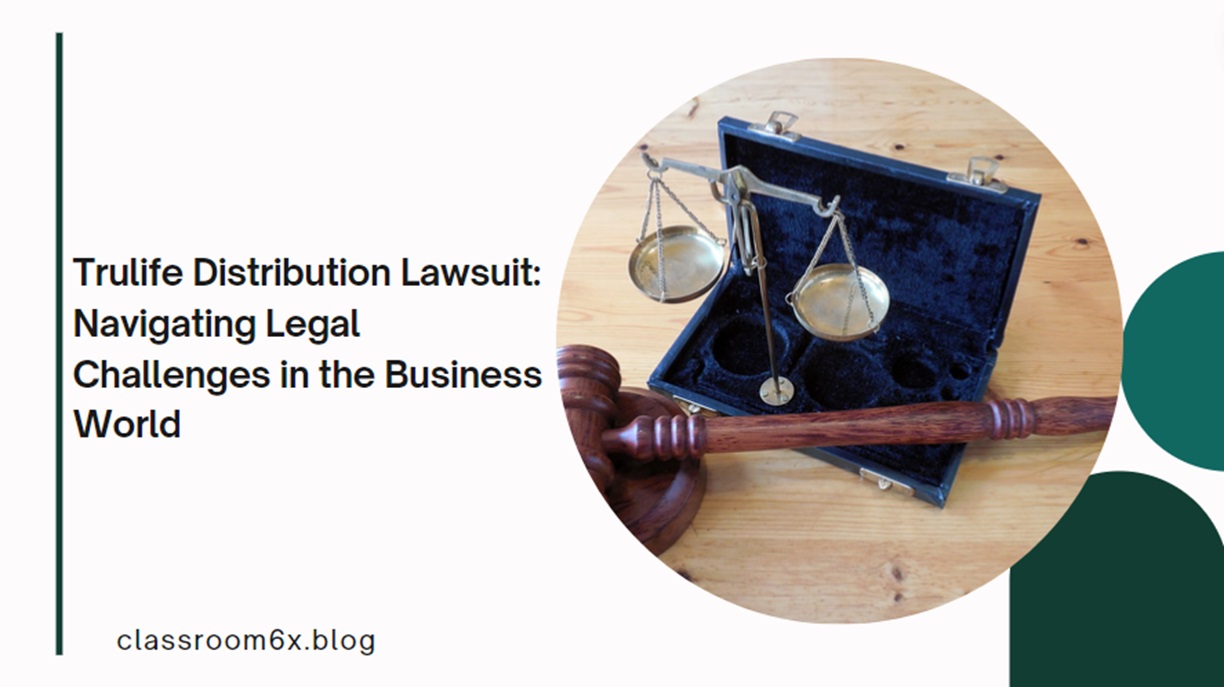
trulife distribution lawsuit
Trulife Distribution lawsuit
In the intricate world of business, lawsuits can emerge as powerful battlegrounds where companies clash over contracts, intellectual property, and market share. One such battle that has captured significant attention is the Trulife Distribution lawsuit. This complex legal saga offers a window into the dynamics of corporate power struggles, shedding light on the stakes involved and the ramifications for all parties concerned. In this article, we will delve into the details of the Trulife Distribution lawsuit, explore its implications, and uncover the broader lessons it offers.
Table of Contents
Background of Trulife Distribution
The Origins of Trulife Distribution
Trulife Distribution, a prominent player in the distribution industry, was founded with the vision of revolutionizing the way products reach consumers. Established in the early 2000s, the company quickly rose to prominence by leveraging cutting-edge technology and innovative logistics solutions. Its focus on efficiency and customer satisfaction propelled it to become a key player in the market.
Expansion and Market Influence
As Trulife Distribution expanded its operations, it began to wield significant influence in the industry. Its extensive network of suppliers, distributors, and retailers allowed it to establish a dominant presence across various sectors. This growth not only boosted its market share but also drew the attention of competitors and regulators alike.
The Catalyst for the Lawsuit
Unraveling the Dispute
The Trulife Distribution lawsuit was triggered by a series of events that exposed underlying tensions within the industry. At the heart of the dispute lay allegations of unfair business practices, breach of contract, and intellectual property infringement. These allegations raised questions about the ethics and legality of certain actions taken by Trulife Distribution.
The Role of Intellectual Property
Intellectual property (IP) emerged as a central issue in the lawsuit. Competitors accused Trulife Distribution of using proprietary technology and trade secrets without proper authorization. This accusation underscored the importance of safeguarding intellectual property rights in an era where technological innovation is a driving force behind business success.
Legal Proceedings and Key Players
The Plaintiffs and Defendants
In the Trulife Distribution lawsuit, the parties involved included both well-established corporations and smaller players seeking to protect their interests. The plaintiffs, comprising rival companies and former partners, alleged that Trulife Distribution’s actions had caused them substantial harm. On the other side, Trulife Distribution vehemently defended its practices, asserting that it operated within the bounds of the law.
The Role of Legal Experts
Legal experts played a pivotal role in the unfolding of the lawsuit. Renowned law firms and attorneys were enlisted to navigate the intricate legal landscape, presenting arguments, evidence, and expert testimonies. Their involvement underscored the high stakes of the case and the importance of legal acumen in resolving complex business disputes.
Courtroom Drama: The Battle Unfolds
The Opening Statements
The courtroom drama commenced with opening statements from both sides, setting the tone for the legal battle ahead. The plaintiffs emphasized the alleged harm caused by Trulife Distribution’s actions, while the defense sought to dismantle these claims by presenting counterarguments and evidence.
Examination of Evidence
The examination of evidence was a crucial phase in the lawsuit, as both parties sought to substantiate their claims and defenses. Documents, emails, and witness testimonies were scrutinized to determine the veracity of allegations and the extent of any wrongdoing. This phase highlighted the meticulous nature of legal proceedings and the importance of presenting a compelling case.
Cross-Examinations and Testimonies
Cross-examinations and testimonies added layers of complexity to the legal battle. Witnesses, including industry experts, former employees, and business partners, provided insights into the inner workings of Trulife Distribution and its competitors. Their testimonies played a pivotal role in shaping the narrative and influencing the court’s perception of the case.
The Verdict and Its Implications
The Court’s Decision
After a protracted legal battle, the court rendered its verdict, which sent ripples throughout the industry. The decision, reached after careful consideration of the evidence and arguments, determined the extent to which Trulife Distribution was liable for the alleged actions. The verdict not only resolved the immediate dispute but also set a precedent for future cases involving similar issues.
Financial and Reputational Impact
The court’s decision had far-reaching financial and reputational implications for all parties involved. Trulife Distribution faced potential monetary damages and the need to reevaluate its business practices. Simultaneously, the lawsuit underscored the importance of ethical conduct and adherence to legal norms in maintaining a company’s reputation.
Lessons Learned from the Trulife Distribution Lawsuit
The Significance of Ethical Practices
The Trulife Distribution lawsuit serves as a cautionary tale about the importance of ethical practices in business operations. Companies must prioritize transparency, integrity, and compliance with legal and ethical standards to avoid legal entanglements that can tarnish their reputation and financial stability.
Intellectual Property Protection
The lawsuit underscores the critical role of intellectual property protection in today’s competitive landscape. Businesses must invest in robust IP strategies to safeguard their innovations and creations from unauthorized use. Additionally, they should be vigilant in respecting the intellectual property rights of others to avoid legal disputes.
Navigating Complex Legal Terrain
The Trulife Distribution lawsuit highlights the intricacies of navigating complex legal terrain. Companies facing legal challenges must engage experienced legal counsel to ensure a thorough understanding of their rights and obligations. Proactive measures, such as conducting legal audits and risk assessments, can help mitigate potential legal pitfalls.
Industry Implications and Future Outlook
Regulatory Scrutiny
The Trulife Distribution lawsuit has prompted increased regulatory scrutiny of business practices within the distribution industry. Regulators are now more vigilant in monitoring compliance with antitrust laws, intellectual property rights, and fair competition standards. Companies must be prepared to adapt to evolving regulatory expectations to avoid legal consequences.
Evolving Industry Dynamics
The lawsuit has also contributed to the evolution of industry dynamics. Companies are reevaluating their strategies to remain competitive while adhering to legal and ethical standards. Collaboration, innovation, and a commitment to customer satisfaction are emerging as key drivers of success in an increasingly complex business environment.
Conclusion: Trulife Distribution lawsuit
The Trulife Distribution lawsuit stands as a testament to the intricate interplay between business, law, and ethics. It serves as a reminder that corporate power struggles can have profound implications for companies, industries, and the broader business landscape. By examining the details of this legal battle, we gain valuable insights into the importance of ethical conduct, intellectual property protection, and legal acumen in navigating the challenges of the modern business world. As the industry continues to evolve, the lessons learned from this lawsuit will undoubtedly shape the future of business practices and corporate governance.



